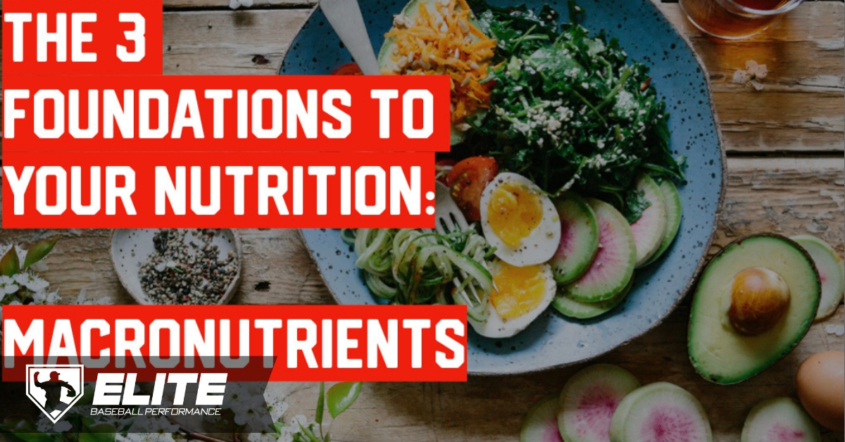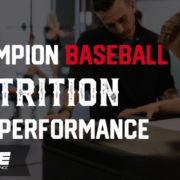The 3 Foundations to Your Nutrition: Macronutrients
When it comes to nutrition and athletes, understanding what you are consuming will go a LONG way! The 3 foundations fall under 1 major umbrella: macronutrients. Often known as “macros,” carbohydrates, fats, and proteins, supply all the energy to perform important bodily functions and daily activities.
The majority of your diet is made up of macronutrients.
Carbohydrates are glucose and can give long term or short-term energy depending on what you eat. Fats are energy dense foods and are separated into two groups: saturated and unsaturated fat. Protein helps recover your muscles faster from workouts.
In this blog, we will break down each macronutrient and go over some food choices!
Download My Top 10 Baseball Game Day Nutrition Tips
Carbohydrates
To start off I will give a little run down of carbohydrates. Carbohydrates are formed from monosaccharides, oligosaccharides, and polysaccharides. The longer and more complex carbohydrate chains take longer for the body to digest. Longer digestion times supply energy over an extended period of time, while shorter chains and shorter digestion times provide quick energy supplies.
Polysaccharides (which are the longest chain) mostly include plants such as: rice, starch, whole grains, and beans.
To digest carbohydrates, it all starts with the mouth…of course. The first place where carbs are broken down is in the saliva. Saliva breaks the chains into polysaccharides, then they pass through the bloodstream into the small intestine.
Finally, they are stored as glycogen, more specifically known as glucose energy.
Now that the bases are covered we can get to how carbohydrates affect a daily diet. Carbs are the fastest macronutrients in and out of the body. When consuming carbs think of the time period you have before you need to exert energy and how long the energy needs to last. For example:
- Right before a workout what should you eat? White bread, fresh or dried fruit. White bread contains smaller chains that are easier to digest. Which gives a brief burst of energy.
- In the morning before work or school, what should you eat? Whole grain bread, lean protein, or other nutrient-rich foods. The wheat bread contains long chains of saccharides which make the energy last longer because they take more time to digest. These are things to consider for your diet. This gives you energy for a longer amount of time.
Fats
Now here is a rundown on fats. The most important fact to understand about fats are the two major categories: saturated and unsaturated fats.
According to the American Heart Association, “Saturated fats are simply fat molecules that have no double bonds between carbon molecules because they are saturated with hydrogen molecules.” To identify them simply look for the fats that are solid at room temperature.
Examples of Saturated Fats
- Butter
- Cheese
- Fatty beef
- Lard and cream
- Lamb
- Pork
Unsaturated fats are usually liquid at room temperature. “An unsaturated fat is a fat or fatty acid in which there is one or more double bond in the fatty acid chain.”
Examples of Unsaturated Fats
- Avocado
- Nuts
- Canola
- Soybean
- Olive oil
- Coconut Oil
Fat is digested slower than carbs because it doesn’t go through the stomach and blood vessels as fast.
In a healthy diet or nutrition plan fats should provide the majority of energy. Each fat gram contains 9 calories, compared to carbs and proteins which only hold 4 calories.
Fats help make and balance steroid hormones, transport fat-soluble vitamins (A, D, E, and K), and provides omega-3 and omega-6 fatty acids.
The healthiest diets have a variety and a balance between fats and avoid consuming processed fats as much as possible.
Download my Top 10 Game Day Nutrition Tips for Baseball Players
Proteins
Protein helps give us the “I’m full’ factor. It evidently takes longer than carbohydrates and fats to digest. Part of the reason pertains to protein starting the digestion process later in the stomach while carbs and fats start earlier. First, the acid in the stomach breaks apart the protein structures to make way for the pepsin to break apart peptide bonds.
Protein should be implemented into your diet, but it might not be the same as your peers. It can be based off your body size, preference, and needs. But the most important part is to have an assortment of protein sources.
- Eggs
- Almonds
- Chicken breast
- Oats
- Cottage cheese
- Greek yogurt
Proteins are also filled with Branched Chain Amino Acids, the building blocks to your recovery and muscle repair. Make sure you have a lean protein source with every meal through the day!
Putting It All Together
Know we know that carbohydrates are the fastest macronutrients in and out of the body.
When consuming carbs think of the time period you have before you need to exert energy and how long the energy needs to last.
Fats should provide the majority of energy and the healthiest diets have a variety and balance between fat foods and avoid consuming processed fats as much as possible.
Finally, protein should be implemented into your diet, but shouldn’t be the same as your peers. It can be based on your body size, preference, and needs. But the most important part is to have an assortment of protein sources.
Adding this to your knowledge of diets and macronutrients has already provided you with the tools for a great nutrition plan.
Nick Esposito
Latest posts by Nick Esposito (see all)
- 5 Sprint Drills Designed for Baseball Players - October 8, 2019
- Nutrition for Baseball Performance - September 10, 2019
- The 3 Foundations to Your Nutrition: Macronutrients - August 13, 2019










Love your inclusion of fats as an energy source. Question though, why would one choose a “lean protein source” if your looking to get healthy fats? Usually the most natural forms of proteins come handy with some fat (chicken fat/skin, fattier steaks, pork chops, etc). If you need fat, might as well include it in your protein source, no?
Great points! Typically most meat is not the same. With the increase of mass produced meat, the quality may not be up to par for what one would expect. Farm fresh or grass fed is typically a leaner option, and the quality is higher for nutrients and vitamins.
So, if I have the ability to get a great source of protein from a lean, grass fed or natural based, I can begin to round out the entire meal with high quality fat sources like avocado, coconut, nuts or other healthy fats. That’s something I’ve personally done as well which is finding sources of the complete meal for fats, protein and carbs and creating a meal that incorporated all of the above.
Hi Nick Esposito,
Thanks a lot for this article.
Glad you enjoyed it! Be on the lookout for more nutrition articles coming up!
Hi Nick,
Awesome content man. Only thing I’d push back on is your list of quality proteins.. How are we going to leave out #1 nutritionally dense food, grass fed, grass finished bison/beef/red meat? Humans have been eating animals for millions of years, and the only animal meat protein you’re going to suggest is chicken breast? C’mon man!!
Definitely a fan of those grass fed and red meat options as well! By no means wasn’t a comprehensive list, and agree with you on that.